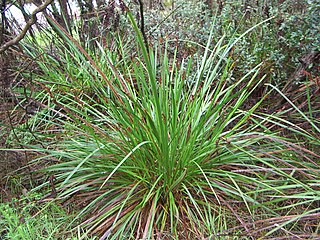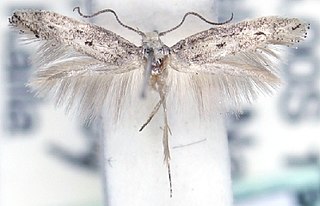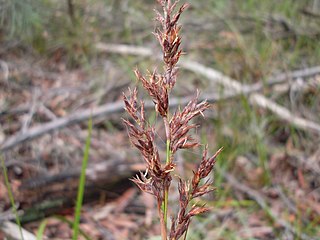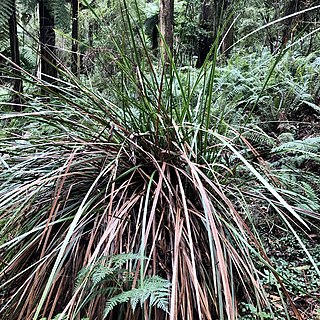
Lepidosperma gladiatum is commonly known as the coast sword-sedge or coastal sword-sedge. It is an evergreen species of sedge that is native to southern coastal areas of Australia. It was described by French botanist Jacques Labillardière in 1805. The Noongar name for the plant is kerbein.

Lepidosperma is a genus of flowering plant of the family Cyperaceae. Most of the species are endemic to Australia, with others native to southern China, southeast Asia, New Guinea, New Caledonia and New Zealand.

Lepidosperma longitudinale is commonly known as the pithy sword-sedge or pith saw-sedge. It is an evergreen species of sedge that is native to swampy areas of most Australian states. It was described by French botanist Jacques Labillardière in 1805.

Lepidosperma laterale, commonly known as the variable swordsedge, is a plant found in south-eastern Australia, New Caledonia and New Zealand. It is often found on sandy soils or rocky areas in wooded areas.
Elachista magidina is a moth of the family Elachistidae that is found in the coastal forests of New South Wales and the Lamington National Park in southern Queensland.
Elachista velutina is a moth of the family Elachistidae that is found on the Fleurieu Peninsula in South Australia.

Elachista carcharota is a moth of the family Elachistidae. It is found in Victoria, South Australia and Western Australia.
Elachista bidens is a moth of the family Elachistidae that is found in Western Australia.

Elachista melanthes is a moth of the family Elachistidae. It is found in the temperate areas of Australia, including south-western Western Australia, South Australia, the Australian Capital Territory and New South Wales.

Lepidosperma concavum, commonly known as the sandhill sword-sedge, is a plant found in coastal regions of south-eastern and eastern Australia. It grows on sandy soils in woodland, forest and heathland.

Lepidosperma filiforme, also known as the common rapier-sedge, is a sedge that occurs in coastal regions of south-eastern Australia and New Zealand. Plants grow to between 0.3 and 1 metre high. The culms are smooth, rigid, terete and between 0.7 and 2 mm in diameter. The leaves are also terete and about 1 mm in diameter, with sheaths that are straw coloured or reddish.

Lepidosperma elatius is a species of plant from sedge family that can be found in Australia. The plant grows to a height of 1–2.5 metres, with leaves and which are convex on both sides, with sharp margins. The spikelets have a drooping spray with a length of 18–65 centimetres (7.1–25.6 in). The plant flowers from November to April.

Lepidosperma chinense, also known as the Chinese scaleseed sedge, is a plant widely distributed across Fujian, Guangdong, Guangxi, Hainan, Hunan, Zhejiang, Indonesia, Malaysia, Papua New Guinea, and Vietnam.

Lepidosperma squamatum is a species of flowering plant in the sedge family, Cyperaceae. It is native to Southwest Australia. It was described by Jacques Labillardière in Novae Hollandiae Plantarum Specimen (1805). The specific epithet squamatum is derived from the Latin for 'scale', in reference to the form of the bracts.

Lepidosperma leptostachyum is a species of flowering plant in the sedge family, Cyperaceae, a native of Southwest Australia.

Lepidosperma viscidum, the sticky saw sedge, is a grass like plant found in south eastern Australia. Usually seen in heath and woodland on sandy and rocky sites, it may grow to 60 centimetres high. This is one of the many plants first published by Robert Brown with the type known as "(M.) v.v." appearing in his Prodromus Florae Novae Hollandiae et Insulae Van Diemen in 1810. The specific epithet viscidum is derived from the Latin with a meaning of "sticky", which refers to the sticky resin from the base and margins of the leaves and stem margins. On drying, the resin turns a red colour.

Lepidosperma canescens is a sedge of the family Cyperaceae that is native to south-east South Australia and Victoria. There are no synonyms.

Lepidosperma amantiferrum is a sedge of the family Cyperaceae that is endemic to Western Australia. It has no synonyms.

Lepidosperma sieberi is a grass-like plant found in southern Australia. Usually seen in heath, forest and woodland, often on moist sandy sites, it may grow to 60 centimetres tall. The specific epithet sieberi honours the botanist and collector Franz Sieber.

Lepidosperma neesii is a grass-like plant found in south eastern Australia. Usually seen in heath and woodland on moist sites, it may grow to 80 centimetres tall. The specific epithet neesii honours the botanist Christian Gottfried Daniel Nees von Esenbeck.

















